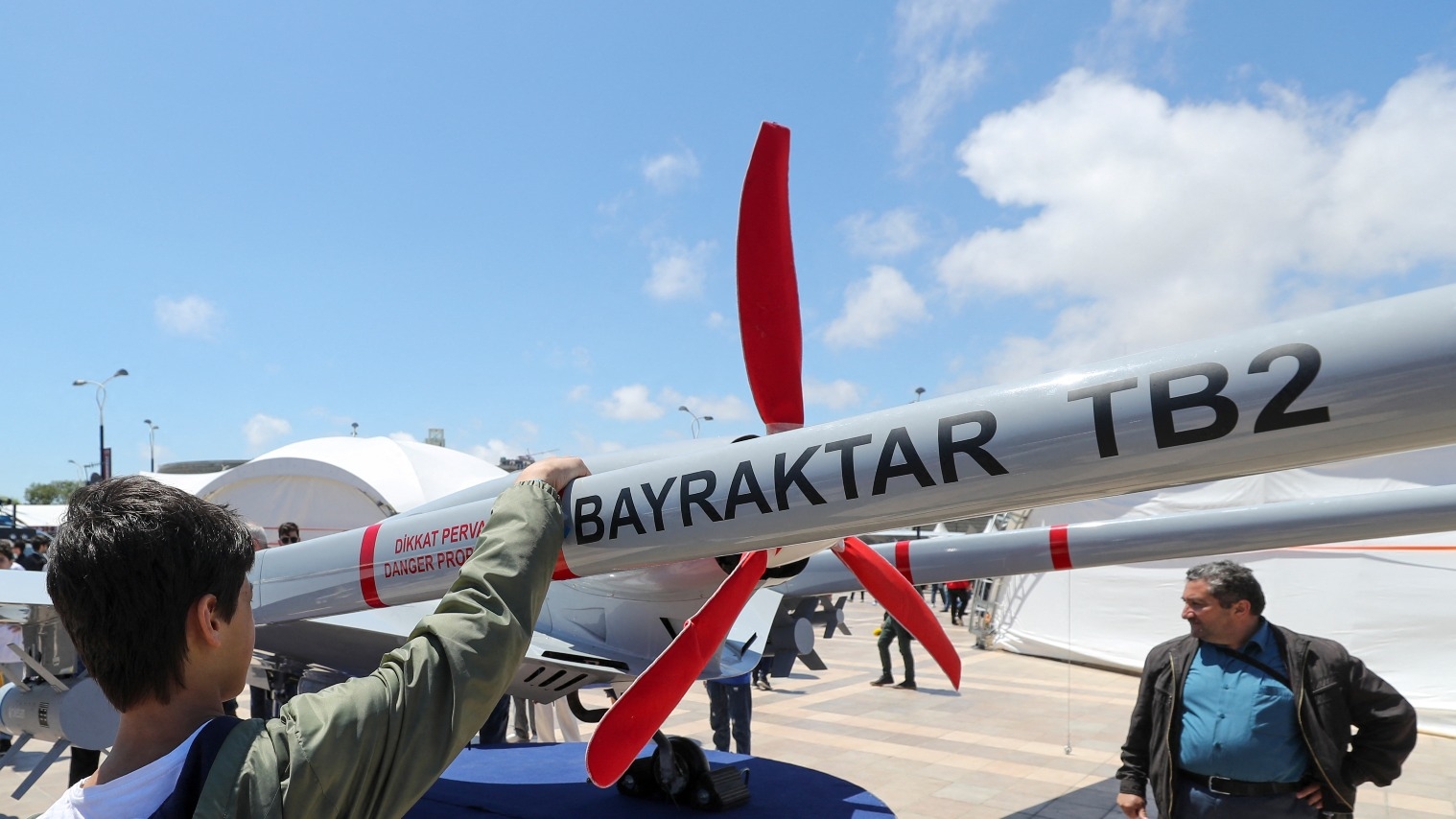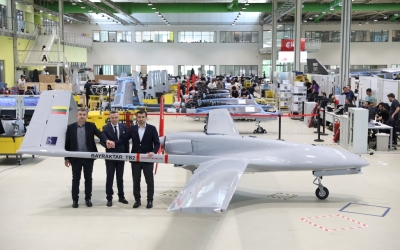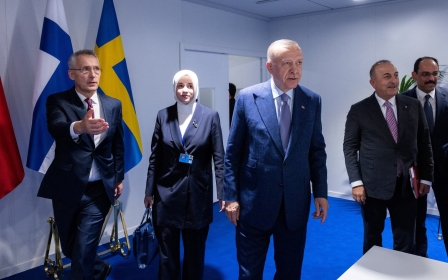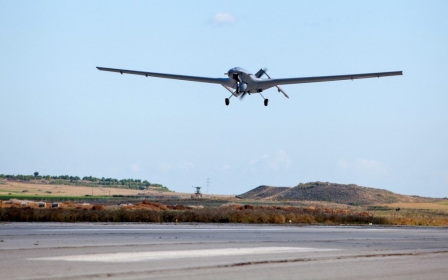Turkey's development of air-to-air missiles for drones unlikely to revolutionise aerial warfare

Turkey's new Bayraktar Akinci (Raider) drone and its upcoming Kizilelma (Red Apple) unmanned fighter aircraft will both be compatible with domestically built air-to-air missiles (AAMs) that could potentially make them less vulnerable to enemy aircraft.
However, as drone experts outlined to Middle East Eye, their air-to-air capabilities will remain limited and will not likely revolutionise air or drone warfare.
Turkey's pro-government Daily Sabah reported in early June that Baykar Defense (the manufacturer of the Akinci and Kizilelma) and the Defense Industries Research and Development Institute (Sage) of the Scientific Technological Research Council of Turkey (Tubitak) are working together to develop AAMs.
The latter is reportedly in the final stage of developing the Bozdogan (Merlin) and the Gokdogan (Peregrine) missiles, within and beyond visual range AAMs.
Turkey has widely exported its Bayraktar TB2. The TB2 has seen successful combat deployments in various conflicts including between Armenia and Azerbaijan, with the latest being Ukraine. However, the TB2 has no air-to-air capabilities, meaning it's vulnerable when operating in contested airspace.
The Akinci - a far larger, more heavily armed, and sophisticated drone - could theoretically prove much less vulnerable to enemy aircraft when armed with Bozdogan and Gokdogan AAMs.
Despite the progress it has made, Turkey will most likely find developing effective air-to-air capabilities for its unmanned aerial vehicles immensely challenging.
In the early 2000s, the US armed some of its MQ-1 Predator drones with short-range Stinger AAMs, which proved highly ineffective. For example, an Iraqi MiG-25 Foxbat jet swiftly shot down one of these drones in 2002 after it fired one of its Stingers and missed.
"The primary issue for arming remotely piloted UAVs such as MQ-1 Predator or Bayraktar TB2 with air-to-air missiles for self-defence is that the sensors on the aircraft only give the remote crew a very limited field of view," Justin Bronk, a senior research fellow for airpower and technology in the military sciences team at the Royal United Services Institute (RUSI), told Middle East Eye.
"This means that whilst they can have good awareness about what is going on around the UAV (unmanned aerial vehicle) within the field of view of the sensor ball (typically pointed at the ground), they are not able to reliably detect or track aircraft around them."
"Also, due to both airframe limitations, control signal lag, and antenna placement, remotely piloted UAVs like TB2 or MQ-1/9 cannot manoeuvre aggressively, which prevents them from reliably getting a decent missile shot against a hostile fighter aircraft or evading a missile shot at them," he added.
Bronk believes the upcoming jet-powered Kizilelma is a "potentially promising project since it would be a true unmanned combat aerial vehicle (UCAV) designed for survivability and lethality in contested airspace (unlike the TB2)."
Nevertheless, for the Kizilelma to realise its full potential, "it would have to not only have effective stealth properties, sensor, and weapons integration (such as the new Bozdogan and Gokdogan AAMs) but also be highly automated in flight so that it is not limited by hostile jamming of a remote control signal and can manoeuvre aggressively without having to avoid losing antenna alignment with a ground control station.
A future where 'drones engage in Top Gun style agile, fast-moving, dogfights over a battlefield is likely to be pretty far off'
- James Rogers, University of South Denmark
"This is not an easy task, and one which is likely to challenge Turkey's vibrant but relatively inexperienced combat aircraft development industry," Bronk said.
Samuel Bendett, a researcher at the Center for Naval Analyses think tank, outlined how AAMs have been deployed on "relatively sizable drones" with comparable speeds to helicopters.
"There are projects that seek to turn UCAVs into adversary drone hunters – prior to the Ukraine war, Russia's Orion UCAV was tested in Crimea against a slow-flying helicopter-type UAV, so it's possible to turn such a military drone into enemy drone hunters," Bendett told Middle East Eye.
"That particular test was done with air-to-surface missiles, but it was an apparent response to the Bayraktar TB2 acquisition by the Ukrainians." Bendett also said Russians are testing drone-hunting capabilities on smaller drones.
"I think using AAMs on larger drones is also possible against a certain type of unmanned aerial targets, but this depends on the AAM capacity and the carrier drone specs as well," he said.
Ukraine highlights difficulties of aerial combat
James Rogers, assistant professor in war studies at the University of Southern Denmark, pointed out that air-to-air capabilities "have not traditionally been a marketable strength of military drones".
"In fact, over the last 20 years, drones have mainly been used by powerful nations against less powerful non-state actors who do not have an especially effective or threatening air power capacity," Rogers told Middle East Eye.
"Put simply, until recently, drones were operated in airspace where command of the air was secured, and few threats were apparent; there was little need for air-to-air. Today this is starting to change with over 100 nations and 50-plus non-state actors deploying various types of weaponised systems in more contested airspace."
He also noted that the war in Ukraine has aptly demonstrated how securing air superiority has become more difficult given the various types of aircraft contesting control of the skies.
And while the Akıncı armed with Bozdogan and Gokdogan AAMs could give it limited defences against other drones and manned aircraft alike, it won't necessarily make Turkey a pioneer or world leader in this particular field.
"Such a system is likely to be purchased by medium and smaller powers, with the US continuing to lead the way in high-tech air-to-air drone systems," Rogers said.
"The DARPA-pioneered LongShot program is one such example. Deployed from a larger aircraft (likely a bomber), the Longshot will extend the range of traditional military aircraft and missiles by being launched at long-range towards a hostile aircraft, where it will then engage the enemy with its own missiles.
"The key point here is that the human pilots and the bomber aircraft can be kept at a safe distance, without threat from the enemy."
Rogers believes that a future in which "drones engage in Top Gun style agile, fast-moving, dogfights over a battlefield is likely to be pretty far off."
"In fact, in the near future, when drones engage enemy airpower, it would be more akin to the movement and speed of an attack helicopter and less comparable to a jet fighter," he said.
"This is even with the development of jet-powered drones like the Kizilelma, which are unlikely to have the adaptability and dexterity of a highly-trained pilot in an expensive F-35."
Middle East Eye delivers independent and unrivalled coverage and analysis of the Middle East, North Africa and beyond. To learn more about republishing this content and the associated fees, please fill out this form. More about MEE can be found here.






